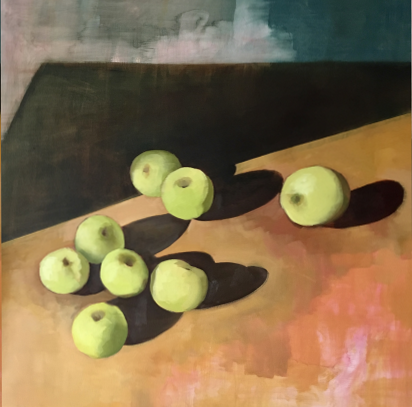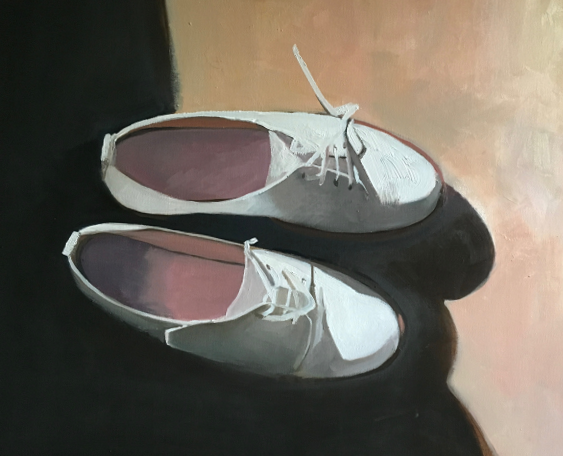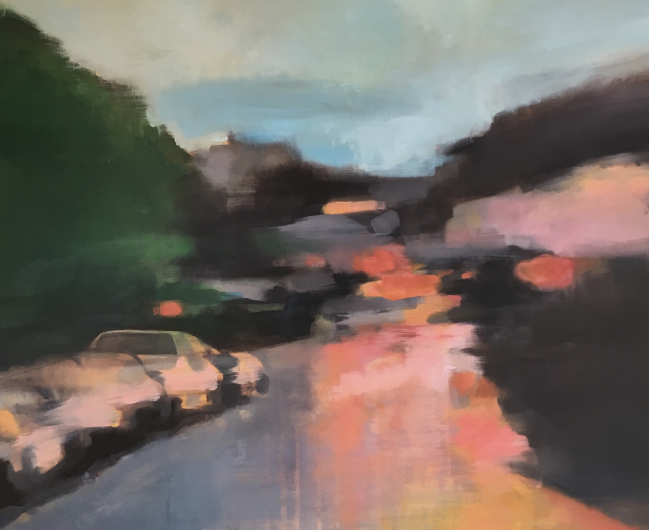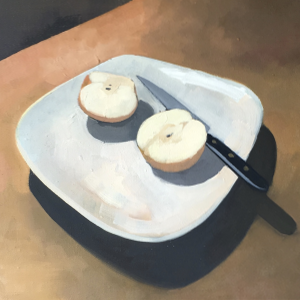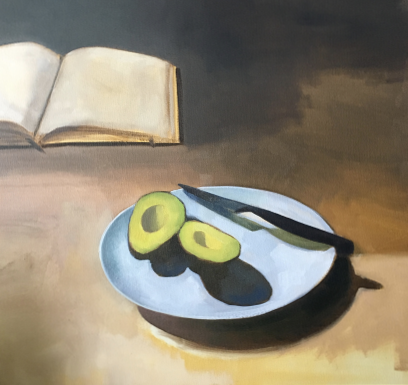About the Painter
After leading a career in public relations in the arts and centering her education around art history, Studio Gallery artist Jane Kell decided in 2010 that it was time for her to begin painting! With her rich background in art history, she pulls inspiration from several famous painters and uses her brushes to examine the beauty of life’s simplest aspects: light, shadow, form, and texture. Jane’s paintings are a testament to the old-as-time advice to “enjoy the little things”, while offering her refreshing and unique insight into the world’s many configurations. To learn more about her artistic practice and outlook on life in a time overshadowed by a pandemic, I asked her some questions about her work:
Pears, Jane Kell, Oil on canvas, 18 x 18 in. Available for purchase by inquiry.
Q: I understand that you have a degree in the History and Theory of art! With this broad knowledge of the arts, what artists would you say have inspired your practice most, and how?
A: I loved studying the history of art; it felt like a huge luxury to spend three years just looking at paintings and learning how to interpret them. I admire many painters, but a couple that stand out are Edgar Degas and Richard Diebenkorn. Degas for his phenomenal draughtsmanship and skill: When you look at his work which was done in the 19th Century, it is very free and modern, and yet so precise. One of my favourite pictures of his is a portrait of his friend Mary Cassatt in the National Gallery in D.C. It has the feeling of being done quickly, and some areas of the canvas are very thinly painted, but it is such an expressive portrait. I love that he has just painted the elements that he felt were important, and didn’t feel the need to fuss over the painting and ‘finish’ every detail. Although I grew up knowing Degas’ work, I discovered Richard Diebenkorn’s work relatively late when I had started to paint myself. He was an American artist working on the west coast in the 1950’s and 60’s. I was immediately drawn to his Berkeley pictures painted in the sixties. I particularly admire his use of colour and his confidence working on a large scale. I also admire the still life and life studies that he worked on during this period, as well as the way he returned to working figuratively again, which after the abstract expressionist movement was controversial. He wrote about his method and thoughts on art, and I have found these insights helpful. He said “one of the most interesting polarities in art is between representation at one end of the stick, and abstraction at the other end, and I’ve found myself all over that stick.” At the time and I think still, there is an unacknowledged taboo about straddling the two worlds of figurative and abstract art, I think a lot of artists feel a pressure to choose one or the other. I started as a figurative artist but now also paint abstractly and feel that the two practices support each other. Diebenkorn’s quiet still-life paintings are unstaged and natural but they are powerful pictures; there is an abstract current that runs through them. This is something that I am aiming for when I work figuratively, whereas the observational, figurative work that I do helps me use colour and line in the abstract paintings.
Mary Cassatt (1879-84), Edgar Degas, National Gallery of Art, Washington D.C.
Untitled (1963), Richard Diebenkorn Foundation.
Still Life with Orange Peel (1955), Richard Diebenkorn, San Francisco Museum of Modern Art.
Q: In 2017 you were given the opportunity to make art in France, and experimented with painting en plein air. How did that experience shape your practice, and have you been able to work en plein air recently under quarantine (either in your backyard or in an isolated outdoor space)?
A: Working en plein air in France in 2017 was a formative experience for me. I am primarily a studio painter and had never worked en plein air before, so I was nervous about it. Once I got started, I actually loved it. I think it really helped that it was a private estate and I had 17 acres of grounds to find a location, so there was no possibility of being watched or bothered by anyone. I found it very freeing and exciting working in the landscape. You need to paint fast and be bold about colour and brushwork as the light and the weather conditions are altering all the time. I felt that my work changed a lot after the trip; it became looser and more confident. I have since been back to the same place in France many times to work, and it is something I will always try to do now. Sadly, with the travel restrictions due, there is no option of doing it this year. I am instead thinking that I might try working outside while I am here in D.C. I live near a beautiful woodland in Palisades, so that would be a good place to work. I find it very difficult to concentrate if I am in a public space, however, so I will have to try and get over that.
Chicken Shed (2018) by Jane Kell, painted en plein air in France, oil on linen, 64 x 49 cm.
Jane Kell’s outdoor work station in France.
Q: How has your work space changed recently, if at all?
A: Over the years I have had many different studio spaces – my first was a garden shed, then a first floor bedroom in our house in London, and then when we came to Washington DC we rented a house which had a fantastic ground floor room with large windows on three walls, which was the perfect studio and I loved working there. Now, because of the pandemic, there are more people in the house. I have had to temporarily give up my studio because it is needed as a bedroom, so that’s not ideal. I am having to use one end of our bedroom as a workspace at the moment, and sometimes I work outside in the garden. In June we are moving house and thankfully I will have a large well-lit studio in the new house.
Water bottle and Bread, Jane Kell, oil on canvas, 76 x 76 cm. 2020.
Slices of Apple, Jane Kell, Oil on canvas 46 x 36 cm, 2020.
Q: What are you working on right now? Is there a particular subject or theme that you are exploring?
A: Recently I have been working on a series of still life paintings. They are usually everyday objects which I have at home and are unstaged. The key thing I am looking for in a subject is interesting light/shadows, as this introduces an abstract element which interests me. I am also working on a large diptych of a swimming pool. Since 2016 I have worked on a series of swimming pool paintings and I have wanted to paint a diptych version for a long time. The pools attract me as subjects because they offer a figurative structure, but they also present a series of bold abstract shapes with interesting light and reflections. The Pool paintings are technically rather demanding to paint, and I am struggling a bit with the diptych; hopefully I will be able to work through it and get it to a point where I think it looks OK. This will be my first American pool; all the others have been Italian.
Jane Kell’s current work as she navigates art-making in quarantine. Her abstract diptych examines variations of light and color in natural bodies of water.
The Pool, Jane Kell, oil on canvas. 76 x 76 cm, 2019.
Q: In your artist statement, you say that your “aim is to reduce your paintings to essential elements”. Has this practice spread to your day-to-day life in quarantine? What are some of your essentials (art-related, home-related, etc.), and how are they helping you through isolation?
A: Yes, I don’t like my work to look fussy and overworked – I want the image to hold your attention and to look calm and serene. If you buy a painting, you have it on your wall (hopefully…) for a long time. I want people to enjoy looking at that painting for years to come, so it needs to hold your attention and also add something to the room. To paint this kind of work I need to be very centered and concentrate hard. That is something that has proved challenging recently. I need to have a work space which is private; somewhere I won’t be interrupted, where I can concentrate and properly focus. At the moment, my husband is working from home and I also have two daughters from the UK living/working at home, so we are very much on top of each other, and finding the space and time to work is difficult. The two things I do which help me stay centered and calm are walking my dog in the woods near the house, and I also do an online yoga class. I only recently started yoga in a new studio in Palisades (blacklotusdc.com) and was loving it, but now that the studio has closed temporarily, I am keeping up with classes online. It provides an element of much needed structure to the day, which also helps to keep my stress levels down.
Q: Lastly, what words of wisdom/advice would you give to artists who are struggling to make work at this time?
A: Find something that interests you and give yourself time to do it justice. If you feel it’s not working, then don’t be afraid to scrape it back and re-work it. Don’t be precious about what you have done. Sometimes I have found myself feeling really frustrated with a picture and have radically scraped back a part or wiped a section off, and all of a sudden the change has added something to the canvas; it has either really improved it or given me a clue as to how I could work on it some more to improve it. I think the key thing is to be bold in your decisions and to notice what is happening on the canvas. Other than that, my two key pieces of advice are:
Try to use the biggest brush possible. If you use a big brush you will make bolder, more confident marks.
Try to stop working on a picture a bit before you feel it is finished – far better to leave something slightly incomplete than overwork it. There will be a better energy in the picture.
Yellow Jug, Jane Kell, oil on canvas 48 x 30 cm, 2020.
From staff contributor Halley Stubis.


